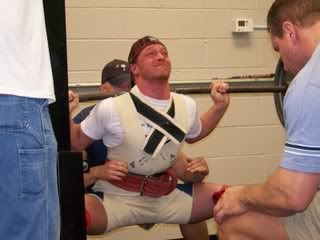Post by gopostal42 on Oct 20, 2006 11:55:01 GMT -5
from a fellow young'n that actually trains with a similar midset that i do except hes really big and strong. enjoy
Training the Deadlift
By Mike Pelosi
For www.EliteFTS.com
--------------------------------------------------------------------------------
The deadlift can be scary. It comes last in a meet and is the most stressful event on the various components that make the body a lifting machine. And well, it even has a scary name. On top of all of that, there are now a hundred and one ways to raise your one rep max on the deadlift. Rack pulls, stiff legs, speed pulls; sumo, conventional, modified; and high hips, low hips, leg drive, hip drive. It can get very, very confusing.
However, while experimenting for my last meet, I came up with the following plan—deadlift heavy once every three weeks. When not deadlifting, do heavy good mornings that simulate the way that you deadlift. And pay attention to overall volume so the squat doesn’t suffer.
Below is the plan I used that took my deadlift from 600 lbs to 685 lbs officially with a 700 lbs gym lift shortly after. I would do this workout on Monday and then squat on Friday.
Week 1: Close stance chain suspended good mornings setting the bar at the belly button or below. Work up to a one rep max followed by a set of 10. Follow this up with rows, a posterior chain exercise beneficial to the cause, and standing abs pull-downs.
Week 2: Stiff leg deadlifts working up to a five rep max followed by a set of 10. Again, follow up with some assistance work.
Week 3: Speed pulls starting at 70 percent of a previous one rep max going no higher than 80 percent, 8–12 singles. Follow up with some assistance work but with less volume and less intensity. This is sort of a de-load week.
Repeat weeks 1–3 again but try to hit PRs in the main exercise. Also, up your assistance work in either volume or intensity when you can. What you raise it by will depend on what type of lifter you are and how you react to certain training methods. I prefer volume.
Week 7: Front squats working up to two heavy sets of five and one set of 15. Keep the assistance work the same but add another posterior chain exercise.
Week 8: Close stance good mornings with eccentric motion working up to a three rep max. Do the same assistance work as in week 7.
Week 9: Take an opening deadlift for 3–5 singles depending on how heavy you wish to go. Don’t do any assistance work. Go home and rest.
Week 10: Do high volume assistance work for the lats, posterior chain, and abs.
Week 11: Rest this week or take off.
Week 12: Pull a new PR at the meet.
This program relies heavily off of good mornings and stiff leg deadlifts. Deadlifting once every three weeks while managing the squat load correctly will allow ample time for recovery. All of the lower back work made my erectors and obliques very tight so I highly suggest doing some sort of warm-up and a good stretching session after each deadlift day.
Mike Pelosi started lifting weights at the age of sixteen as a 400 lbs high school student trying to impress the ladies. Since then, Mike has competed in Strongman and powerlifting events. He placed first in the heavyweight novice class at the MA Strongest Man 2006 and first in the heavyweight open class at New England's Strongest Man 2006. His best official lifts are a 766 lbs squat, 438 lbs bench press, 685 lbs deadlift, and a 1846 lbs total done at the age of 18 in the SHW class. Now 19 years old, Mike plans on furthering his success in the strength athletics field. He trains at Total Performance Sports
www.elitefts.com/documents/training_the_deadlift.htm
Training the Deadlift
By Mike Pelosi
For www.EliteFTS.com
--------------------------------------------------------------------------------
The deadlift can be scary. It comes last in a meet and is the most stressful event on the various components that make the body a lifting machine. And well, it even has a scary name. On top of all of that, there are now a hundred and one ways to raise your one rep max on the deadlift. Rack pulls, stiff legs, speed pulls; sumo, conventional, modified; and high hips, low hips, leg drive, hip drive. It can get very, very confusing.
However, while experimenting for my last meet, I came up with the following plan—deadlift heavy once every three weeks. When not deadlifting, do heavy good mornings that simulate the way that you deadlift. And pay attention to overall volume so the squat doesn’t suffer.
Below is the plan I used that took my deadlift from 600 lbs to 685 lbs officially with a 700 lbs gym lift shortly after. I would do this workout on Monday and then squat on Friday.
Week 1: Close stance chain suspended good mornings setting the bar at the belly button or below. Work up to a one rep max followed by a set of 10. Follow this up with rows, a posterior chain exercise beneficial to the cause, and standing abs pull-downs.
Week 2: Stiff leg deadlifts working up to a five rep max followed by a set of 10. Again, follow up with some assistance work.
Week 3: Speed pulls starting at 70 percent of a previous one rep max going no higher than 80 percent, 8–12 singles. Follow up with some assistance work but with less volume and less intensity. This is sort of a de-load week.
Repeat weeks 1–3 again but try to hit PRs in the main exercise. Also, up your assistance work in either volume or intensity when you can. What you raise it by will depend on what type of lifter you are and how you react to certain training methods. I prefer volume.
Week 7: Front squats working up to two heavy sets of five and one set of 15. Keep the assistance work the same but add another posterior chain exercise.
Week 8: Close stance good mornings with eccentric motion working up to a three rep max. Do the same assistance work as in week 7.
Week 9: Take an opening deadlift for 3–5 singles depending on how heavy you wish to go. Don’t do any assistance work. Go home and rest.
Week 10: Do high volume assistance work for the lats, posterior chain, and abs.
Week 11: Rest this week or take off.
Week 12: Pull a new PR at the meet.
This program relies heavily off of good mornings and stiff leg deadlifts. Deadlifting once every three weeks while managing the squat load correctly will allow ample time for recovery. All of the lower back work made my erectors and obliques very tight so I highly suggest doing some sort of warm-up and a good stretching session after each deadlift day.
Mike Pelosi started lifting weights at the age of sixteen as a 400 lbs high school student trying to impress the ladies. Since then, Mike has competed in Strongman and powerlifting events. He placed first in the heavyweight novice class at the MA Strongest Man 2006 and first in the heavyweight open class at New England's Strongest Man 2006. His best official lifts are a 766 lbs squat, 438 lbs bench press, 685 lbs deadlift, and a 1846 lbs total done at the age of 18 in the SHW class. Now 19 years old, Mike plans on furthering his success in the strength athletics field. He trains at Total Performance Sports
www.elitefts.com/documents/training_the_deadlift.htm






